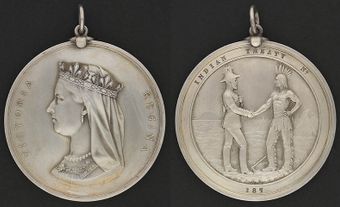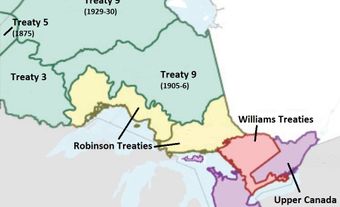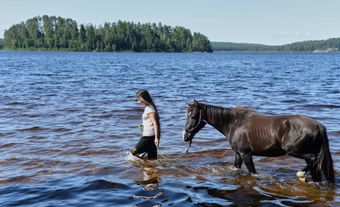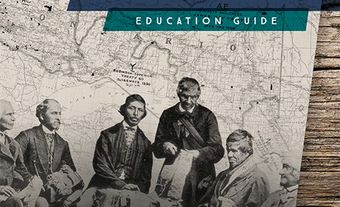McKee’s Purchase of 1790 (also known as the McKee Treaty and Treaty 2) was an early land agreement between Indigenous peoples and British authorities in Upper Canada (later Ontario). It is the southernmost Upper Canada treaty and consisted of a large strip of territory from the southwestern shore of Lake Erie north to the Thames River and east to a point southwest of modern-day London, Ontario. This land was made available for settlement by Loyalists who were displaced by the American Revolution.

Historical Context
In 1701, the French founded Fort Detroit. Over the years, a settlement gradually spread along both sides of the Detroit River on land granted to settlers by its Indigenous occupants. After the fall of New France in 1760, the area became British territory by the Treaty of Paris in 1763, which gave France’s North American possessions to Britain. The new British commanders at Detroit knew of these grants, which were contrary to the Royal Proclamation of 1763. In accordance with that document, only the Crown could negotiate for land from the Indigenous peoples who lived there and then subsequently grant or sell it to settlers. In 1771, Major-General Thomas Gage, commander-in-chief of British forces in North America, said that such grants were illegal, must stop and any buildings erected in Indigenous territory were to be destroyed. While Gage’s instructions were followed elsewhere, in the Detroit area they were either ignored or not enforced.
As a result of the American Revolution (1775-83), all the lands south or west of the Great Lakes became the territory of the new United States. The western posts at Oswego, Niagara, Detroit and Michilimackinac, however, remained in British hands until until 1795, after Jay’s Treaty was ratified. Meanwhile, many residents of the Thirteen Colonies who remained loyal to Britain fled to other countries. Some 6,000 to 10,000 Loyalists, as well as Haudenosaunee refugees, moved into present-day Ontario. The main areas of initial settlement were along the St. Lawrence River to the Bay of Quinte, on the Niagara Peninsula and along the Grand River. This increase in population later led to the division of Quebec into Upper and Lower Canada in 1791. In 1841, Upper and Lower Canada were renamed respectively Ontario and Quebec.
Treaty No. 116
In 1784, some chiefs of the Odawa and Ojibwe in Detroit granted land at the mouth of the Detroit River to nine officers of the British Indian Department, including Deputy Indian Agent Col. Alexander McKee. This parcel was usually known as “the Indian Officers’ land” and consisted of about seven miles (18 kilometres) square fronting on the river. It was given to them in recognition of past services to the Indigenous peoples of the area, especially during the Revolutionary War. Although in violation of the Royal Proclamation, these officers were allowed to retain the land with the knowledge of the British lieutenant-governor at Detroit and the approval of Quebec Governor Sir Frederick Haldimand.
This grant appears to have been confirmed by Treaty 116, signed by representatives of the Odawa and Ojibwe of Detroit on 15 May 1786. The parcel in question was “a certain tract of land on the south side of the Detroit River, also an island (Bois Blanc) in the mouth of said river.” The treaty was signed “in consideration of the goodwill, friendship and affection” for Alexander McKee, “who has served with us against the enemy during the late war.” McKee’s mother was Shawnee and he had been raised in the hinterland in the ways of his mother’s people.
McKee was born in what is now Pennsylvania around 1735. He worked as a fur trader and Indian Agent in the Ohio River area but supported the British in the American Revolutionary War. He relocated to Detroit as a United Empire Loyalist and supported Indigenous allies fighting against the Americans. In the 1780s and 1790s he was a key figure organizing Indigenous resistance to American settlement in Ohio and Michigan, but that alliance fractured after the British withdrew from Detroit in 1796. He died around 1799 in what is now Southwestern Ontario.
Further Negotiations
The officers who had been granted the land remained concerned that their ownership could be overturned by the authorities at any time. This was especially so after the creation of Land Boards in 1788, which had been established to legally grant land to new settlers coming into the area. Alexander McKee joined the board in 1789 and, in May 1790, he convened a council at Detroit with Indigenous representatives to formalize the earlier agreements. Another purpose was to acquire territory for the board to grant. In fact, lengthy discussions between McKee and various Indigenous peoples took place before the formal council as he travelled throughout the area. Another two days of discussions preceded the formal treaty signing on 20 May. Fur traders, officials of the Indian Department and army officers attended the council, as well as chiefs of the Odawa, Ojibwe Potawatomi and Wyandot Nations of Detroit.
McKee had been given instructions to purchase the shoreline between Long Point on Lake Erie and the Chenail Ecarté River where it empties into the St. Clair River. Two small tracts of land within the purchase were retained for Indigenous use, known as the Huron Reserve and the Huron Church Reserve. When questioned later about these exceptions by the Land Board, McKee maintained they were necessary to obtain the rest of the tract. Major Patrick Murray, the British military commander at Detroit, supported McKee and stated that the best possible arrangements had been made for the Crown.
Outcome
The land that McKee obtained for the British extended as far inland as the Thames River. The chiefs sold the land for goods worth 1,200 pounds. Among the items were 840 pairs of blankets, various kinds of cloth, ribbons and thread and a dozen black handkerchiefs, valued at 722 pounds; 240 plain hats, 60 guns, 20 rifles, ammunition, 2,000 flints, 360 mirrors, 144 scissors, 288 combs, 1,000 fishhooks and 272 kilograms of brass kettles, worth 290 pounds; and 39 gallons of rum, a bullock, 181 pounds of tobacco, 24 laced hats, 1,584 pipes and 288 knives, valued at 187 pounds. A few other items of lesser value were included.
The surrender of 1790 legitimized the land transfers of 1784 and 1786 as well as many other private illegal sales of Indigenous land to settlers in the southernmost part of modern Ontario.
The impact for Indigenous communities was substantial including loss of hunting territory.
Consultation on Commemorative Plaque
In 1931, McKee’s Purchase was designated an Event of National Historic Significance. In 1934, a unilingual Historic Sites and Monuments Board of Canada plaque was unveiled commemorating the purchase, which was replaced by a bilingual version in 1967. It is mounted on a stone cairn in Blenheim Memorial Park in the Municipality of Chatham-Kent.
According to Parks Canada media relations, this plaque was identified by their historians in 2020 as potentially containing “colonial assumptions and outdated terminology.” As such, the plaque itself and the wording is under review at this time. As of 2021, stakeholders and Indigenous communities are being consulted to modernize and provide more context surrounding the designation.

 Share on Facebook
Share on Facebook Share on X
Share on X Share by Email
Share by Email Share on Google Classroom
Share on Google Classroom











